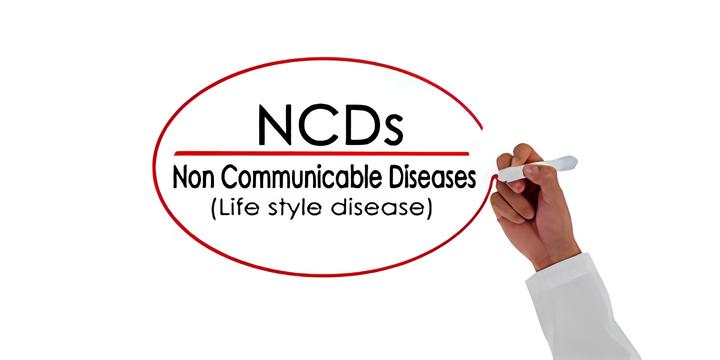Introduction
Noncommunicable diseases (NCDs) have crept up on us to become the number one cause of death and disease in the world. Unlike infectious diseases, NCDs cannot be directly transmitted from human to human but instead occur more as a function of an interplay between environment, genetics, and lifestyle. Chronic illnesses such as cardiovascular diseases, diabetes, chronic respiratory illnesses, and cancer account for almost 74% of all deaths globally. The increased rate of NCDs has contributed to increasing healthcare spending, economic loss, and poor quality of life among millions of individuals. Familiarity with their etiology, risk factors, and prevention is the key to lessening their burden.

What Are Noncommunicable Diseases?
Noncommunicable diseases are chronic conditions of health that develop slowly and can often be prevented. The four major NCD types are:
Cardiovascular Diseases – Heart attacks, strokes, and hypertension are some of the most prevalent NCDs and are the top killer worldwide.
Chronic Respiratory Diseases – Conditions like chronic obstructive pulmonary disease (COPD) and asthma infect the lungs and airways, impairing the ability to breathe.
Cancer – Uncontrolled cell growth leading to malignant tumors can affect various organs and significantly impact overall health.
Diabetes – A metabolic disorder that affects blood sugar regulation, leading to severe complications if not managed properly.
Causes and Risk Factors
Several factors contribute to the development of NCDs. While some are beyond individual control, such as genetics and age, others are linked to lifestyle choices. The primary risk factors include:
Unhealthy Diet- Excessive intake of such diets is believed to cause obesity, diabetes, and heart diseases.
Physical Inactivity- A sedentary lifestyle with no physical activities results in a weak heart and muscles, which encourages cardiovascular diseases and diabetes.
Tobacco Use- Cigarette smoking is the major cause of lung disease, cancer, and heart disease complications.
Alcohol abuse – Excessive consumption of alcohol may harm the liver, increase blood pressure, and lead to other serious health ailments.
Environmental contamination – Air pollution, chemicals, and toxins significantly increase the risk of cancer and respiratory disease.
Mental disease and stress – Stress and mental disease like depression and anxiety may lead to physical sickness like diabetes and heart disease.
The Global Burden of NCDs
NCDs pose a significant challenge to global health systems, particularly in low- and middle-income countries, where access to healthcare and preventive measures may be limited. According to the World Health Organization (WHO), NCDs account for over 41 million deaths annually. The economic impact is staggering, as healthcare expenses for managing chronic conditions and lost productivity place enormous burdens on governments and individuals alike. Addressing this issue requires urgent action at both individual and policy levels.
Prevention Strategies
Although NCDs are an emerging health issue, they are mostly preventable by making lifestyle changes and through early interventions. The following are some of the best ways to lower the risk of contracting these diseases:
Take on a Healthy Diet – A diet of whole foods like fruit, vegetables, lean proteins and whole grains is effective in drastically reducing the prevalence of NCDs. An intake reduction in salt, sugar, and trans fats is necessary for cardiovascular disease prevention and combating obesity.
Partake in Regular Physical Activity – A minimum of 150 minutes every week of moderate-intensity activity such as walking, cycling, or swimming is likely to contribute to cardiovascular and general health.
Stop Smoking – Avoidance of the consumption of tobacco products reduces the chance of developing lung cancer, cardiovascular diseases, and respiratory diseases. Most countries provide smoking cessation services for people wishing to stop.
Limit Alcohol Consumption – Limiting alcohol consumption can avoid liver disease, high blood pressure, and other conditions.
Regular Health Check-Ups – Regular check-ups with physicians can identify early NCD signs so that timely intervention and control are possible.
Manage Stress and Mental Well-being – Practice of relaxation methods like meditation, deep breathing, and mindfulness can manage stress and its effect on physical health.
Create Supportive Environments – Governments, public authorities, and communities must collaboratively implement policies to help create healthier lifestyles through promoting physical activity, alleviating air pollution, and enhancing the availability of nutrient-rich food.
Conclusion
Noncommunicable diseases are a silent epidemic that continues to affect millions of people worldwide. The good news is that many of these conditions are preventable through healthier lifestyle choices and early interventions. Governments, healthcare organizations, and individuals must collaborate to raise awareness, implement effective policies, and create supportive environments that promote well-being. By taking proactive steps today, we can reduce the burden of NCDs and build a healthier future for generations to come.








Leave a Reply